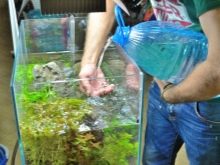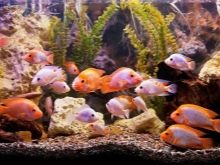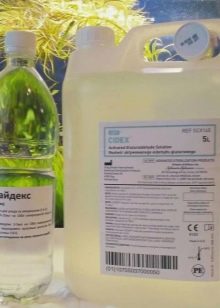Sometimes the plants in the aquarium acquire an unnatural shade. If you saw that they were covered with a brownish-brown coating - this is the first symptom that processes occur in an artificial reservoir that violate the existing ecosystem. If dark, almost black spots appear - you need to urgently take action, the plant is affected by black algae, which grows quite quickly.

What harm?
Black plaque on the representatives of the aquarium flora appears as a result of the propagation of the “black beard”, it is the lowest algae of black-brown color, which entangles leaves, substrate, decoration elements and even covers the glass walls of the tank. From a botanical point of view, black beard is a multicellular filamentous algae, the size of the filaments is 5-6 cm. The propagation rate of the algae is so high that it can entangle the entire aquarium flora in a rather short time.
Despite this, that this algae is not a parasite, it destroys plant tissues and darkens them. If the situation is not taken under control and not get rid of adversity as quickly as possible, then the plants can wither and even die.
In addition, the black beard often settles on the ground, grottoes, snags, as well as on the filter and compressor - it is very difficult to clean them from plaque and remove the algae.

Reasons for the appearance
The causes of the appearance of a black beard in an artificial reservoir are the most primitive, Here are just some of them.
- Stagnant water. As a result of the vital activity of fish, waste accumulates in the tank, they emit nitrates, nitrites and phosphate, which create an environment favorable for the growth and reproduction of algae.To avoid clogging of the reservoir, it is necessary to regularly change the water, it is advisable to do this weekly.
- Lack of lighting. Over time, the brightness of aquarium lamps decreases, the lighting becomes dimmer, in this light, as a rule, algae begin to develop much more actively.
- Excess feed. It is known that some fish feed on black beard, because it is algae, but if there is too much food, then the need for plant food from aquarium pets will not arise.
- Violation of the rules of population density of fish. A large number of fish in the aquarium leads to excessive accumulation of organics, which has the most harmful effect on the existing biocenosis.
- Accumulations in the substrate. With excessive filtration and constant digging in the ground with large fish, particles of food and other biomass begin to penetrate the upper layers of the water. In this case, the algae lurking in the substrate find a comfortable environment for active growth.
- Sharing of infected plants and decorative elements (stones or driftwood). In order to avoid the appearance of the disease, when purchasing any aquarium plant or decoration, you must first hold it in clean water and check if there are dark swaying villi, and if you notice such threads, the plant is sick.



It is very easy to identify a black beard - in this case, spots with fluffy threads of black-green color appear on surfaces and plants.
However, if there are no obvious signs of damage, this does not mean that there is no problem. Perhaps it is already inside the tank and just waiting for the conditions suitable for sharp reproduction.

Ways to fight
The options for combating black beard in an aquarium are divided into chemical and biological. When using the chemical method, drugs are used - they quickly cope with the misfortune, but at the same time they can harm the fish, so we dwell in more detail on all possible methods of struggle.

Settlement of individual varieties of snails and fish
As you know, ordinary catfish, catfish-ancistruses, as well as Siamese algae-eater and cyprinids eat black beard. At the same time, it should be borne in mind that it is quite tough, because just because they do not start to feed on it. During treatment of the reservoir, it is better not to give any other food to the inhabitants of the aquarium, only in this case they will turn their attention to black filamentous algae. From snails, a possible solution to the problem may be to launch a small handful of small ampoules into the aquarium - they cope well with any kind of algae.
But immediately after the enemy is destroyed, it is advisable to remove the ampoule from the water, otherwise they will quickly transfer to higher plants.

Plant Sharing
It is noted that the placement of hygrophiles, elodea and lemongrass, as well as hornwort, vallisneria, nyass and Indian rotala in the reservoir, promotes the removal of black beard. The point here is that algae in the first place attacks the simplest plants, while higher ones, with rapid development, begin to actively absorb nutrients. To do this, you should purchase as many seedlings as possible and create favorable growth conditions for them. It will be useful to use special fertilizers containing iron and manganese. In the process of plant growth, it is necessary to prune, because young shoots more actively absorb beneficial components from water.
Under these conditions, a black beard is not very comfortable, its hairs lighten, and then die in everything.



Restart aquarium
This is a fairly radical way, which is used for a large degree of infection. To do this, you need to place all the fish in a temporary tank, drain all the liquid, and destroy the damaged plants, thoroughly clean and boil the substrate and decorative elements. After that, with the help of bleach and hot water, they clean the walls of the aquarium, thoroughly wash with cool water and restart.


Battery usage
This is one of the most unusual ways that aquarists “with experience” often resort to. In this case, no one needs to be evicted, the recipe is simple: they take a pair of copper batteries from the contacts, dip them in water and leave them for 3-5 days.
The releasing electrolytes and microcurrents have a detrimental effect on black algae, while the fish themselves and higher plants remain intact.

Vinegar application
A 3% solution of vinegar has good efficiency, it is dissolved in water to a slightly acidic environment and the affected plant is lowered in such a way as not to affect the root system. Vinegar contributes to the destruction of villi. After this, the plant is thoroughly rinsed in clean water and planted back. Such a procedure is absolutely safe for the sprouts and aquarium inhabitants themselves. The method is optimal in the very first stages of infection, when the beard captured only 1-2 plants.
Table vinegar can be replaced with malic acid or boric acid can be used instead.


Alkaline mode
Blackbeard does not tolerate hard water, therefore, to eliminate it, increase the corresponding parameter to 8 units. To do this, add 10% potassium chloride in the calculation of 2 ml per liter of water and 7% magnesium sulfate (2 ml per 1 liter) or use baking soda (0.2 g per 1 liter).
Keep in mind that the conditions should be changed slowly, otherwise the inhabitants of the reservoir can be poisoned.

Antiseptics
The antiseptics furatsilin or furazolidone are highly effective - for this they are dissolved for several days in aquarium water. It may turn yellow; this should not scare the breeder.

Borax
Dissolving borax will quickly destroy all black algae in the tank, but remember that before treatment, all fish must be evicted in a separate container, otherwise they will simply die.

Special antiseptics
If the aquarium is damaged by a black beard, you can fight it with special antiseptics, which quickly cleanse the water of the disease. Most often use Sidex, which is completely safe for fish, shrimp and snails., but it doesn’t always show effectiveness, therefore, it is better to give preference to the more expensive AlgaeFix. It is distinguished by the speed of action, but crustaceans are not friendly with this medicine - when it is used, they die.
Some veterinarians recommend using Aldehyde + CO2, but in any case, you must first read the instructions for use of the drug and find out about possible contraindications.



Preventive measures
As they say, a disease is always easier to prevent than to treat, therefore, in order to protect the aquarium and not create conditions comfortable for breeding a black beard, you just need to carefully monitor the biocenosis in it. Each week, change the water by about 25-30%. Avoid overpopulation of the artificial pond.
When buying any new fish, quarantine them for 15-20 days.

Before planting, any new plant should be decontaminated; for this, use Bitsillin-4 (a dose of 15 thousand units is needed per liter of water) or penicillin (based on 5 mg per 1 liter). The drug is diluted in water, heated to 25-26 degrees and put the plant there. For 2 hours, the jar is kept in a dark place, and then transferred to the light. After a day, the plant is washed and placed in an aquarium.
Alternatively, you can use a solution of hydrogen peroxide (20 ml per 100 liters of water). Some aquarists use bleach, which is quite effective against algae, but some plants (Anubias, Kabomba and Elodea) tolerate it quite poorly.Watch the nitrate content - their concentration should not go beyond 5 mg per / liter, for this you need not to overfeed the fish, use filters and siphon the soil at least once a week. Following these simple rules will ensure that your micro aquarium has a favorable microenvironment.
You will learn more about how to get rid of black algae in an aquarium in 2 weeks.










